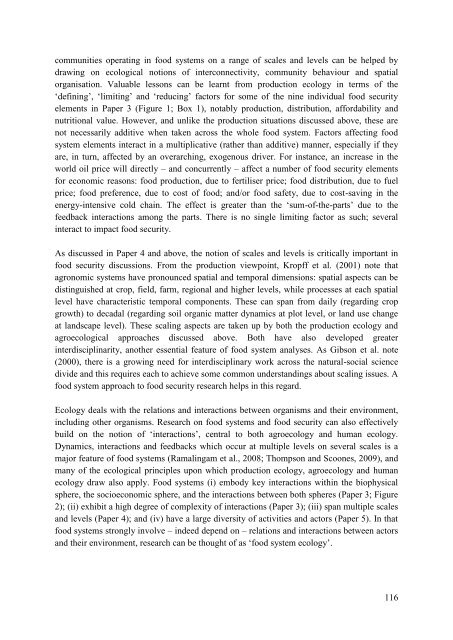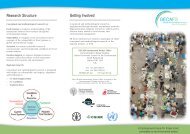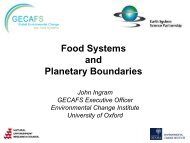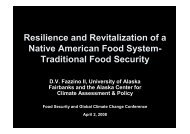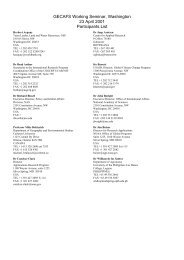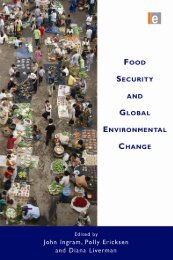From Food Production to Food Security - Global Environmental ...
From Food Production to Food Security - Global Environmental ...
From Food Production to Food Security - Global Environmental ...
- No tags were found...
You also want an ePaper? Increase the reach of your titles
YUMPU automatically turns print PDFs into web optimized ePapers that Google loves.
communities operating in food systems on a range of scales and levels can be helped bydrawing on ecological notions of interconnectivity, community behaviour and spatialorganisation. Valuable lessons can be learnt from production ecology in terms of the‘defining’, ‘limiting’ and ‘reducing’ fac<strong>to</strong>rs for some of the nine individual food securityelements in Paper 3 (Figure 1; Box 1), notably production, distribution, affordability andnutritional value. However, and unlike the production situations discussed above, these arenot necessarily additive when taken across the whole food system. Fac<strong>to</strong>rs affecting foodsystem elements interact in a multiplicative (rather than additive) manner, especially if theyare, in turn, affected by an overarching, exogenous driver. For instance, an increase in theworld oil price will directly – and concurrently – affect a number of food security elementsfor economic reasons: food production, due <strong>to</strong> fertiliser price; food distribution, due <strong>to</strong> fuelprice; food preference, due <strong>to</strong> cost of food; and/or food safety, due <strong>to</strong> cost-saving in theenergy-intensive cold chain. The effect is greater than the ‘sum-of-the-parts’ due <strong>to</strong> thefeedback interactions among the parts. There is no single limiting fac<strong>to</strong>r as such; severalinteract <strong>to</strong> impact food security.As discussed in Paper 4 and above, the notion of scales and levels is critically important infood security discussions. <strong>From</strong> the production viewpoint, Kropff et al. (2001) note thatagronomic systems have pronounced spatial and temporal dimensions: spatial aspects can bedistinguished at crop, field, farm, regional and higher levels, while processes at each spatiallevel have characteristic temporal components. These can span from daily (regarding cropgrowth) <strong>to</strong> decadal (regarding soil organic matter dynamics at plot level, or land use changeat landscape level). These scaling aspects are taken up by both the production ecology andagroecological approaches discussed above. Both have also developed greaterinterdisciplinarity, another essential feature of food system analyses. As Gibson et al. note(2000), there is a growing need for interdisciplinary work across the natural-social sciencedivide and this requires each <strong>to</strong> achieve some common understandings about scaling issues. Afood system approach <strong>to</strong> food security research helps in this regard.Ecology deals with the relations and interactions between organisms and their environment,including other organisms. Research on food systems and food security can also effectivelybuild on the notion of ‘interactions’, central <strong>to</strong> both agroecology and human ecology.Dynamics, interactions and feedbacks which occur at multiple levels on several scales is amajor feature of food systems (Ramalingam et al., 2008; Thompson and Scoones, 2009), andmany of the ecological principles upon which production ecology, agroecology and humanecology draw also apply. <strong>Food</strong> systems (i) embody key interactions within the biophysicalsphere, the socioeconomic sphere, and the interactions between both spheres (Paper 3; Figure2); (ii) exhibit a high degree of complexity of interactions (Paper 3); (iii) span multiple scalesand levels (Paper 4); and (iv) have a large diversity of activities and ac<strong>to</strong>rs (Paper 5). In thatfood systems strongly involve – indeed depend on – relations and interactions between ac<strong>to</strong>rsand their environment, research can be thought of as ‘food system ecology’.116


